Apple today shared a new App Store study that it commissioned from economists at Analysis Group, with the report highlighting the success of third-party developers on the App Store. The study comes as Apple is facing concerns about the prioritization and dominance of its apps on the App Store as well as regulatory pressure to open up iOS to sideloading and alternate app store options.
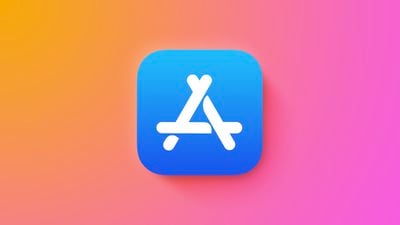
Apple's aim is to offer up facts on the ecosystem the App Store has created and the content that developers are creating for it. The first part of the study focuses on the numerous ways that developers can reach consumers outside of the App Store, through non-iOS devices like other smartphones, PCs, and consoles and through other digital marketplaces.
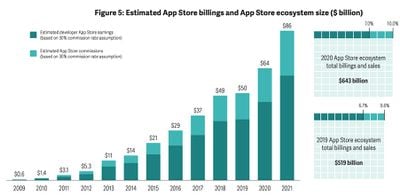
The second part of the study focuses on the growth of the App Store over time (there are now 1.8 million apps), 99.9 percent of which are third-party apps as the study is quick to point out that Apple has just 60 apps that are competing with third-party apps.
The final part of the study focuses on the breadth of third-party apps that are available as alternatives to Apple-created apps, and it points out that for many categories like social networks, food, travel planning, and dating services, third-party apps are the only option as Apple does not compete in these categories. It also points out that across most app types, Apple's apps are "eclipsed in popularity and account for a relatively small share of usage."
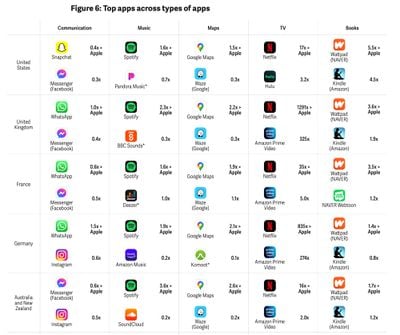
As an example, the top apps in each App Store category are listed and compared against Apple apps. In the U.S., Spotify is 1.6x more popular than Apple Music among Apple users in terms of daily active users or time spent in the app, and Netflix is 17x more popular than Apple TV+, and Apple's share among TV apps has never exceeded four percent in the countries included in the study. "Apple's own apps are rarely the most popular app of a particular type, and account for a small share of app usage," reads the report.
Apple's share of most app categories falls below 40 percent, according to the study, and is often lower. When it comes to communication apps like Phone, Messages, and others, Apple has a 41 percent share in the U.S. because it competes with WhatsApp, Messenger, Instagram, and others, and for the maps category, it has a 36 percent share. In the TV category, it has a three percent share, and in the reading category, it has an eight percent share.
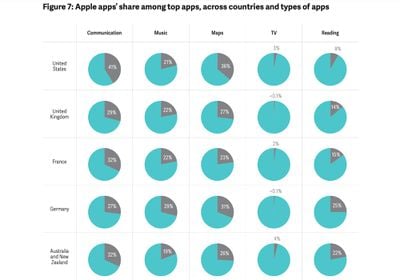
The study takes a deep dive into several app categories where Apple competes, including communication, reading, music streaming, mapping, TV and video streaming, games, health and fitness, and news.
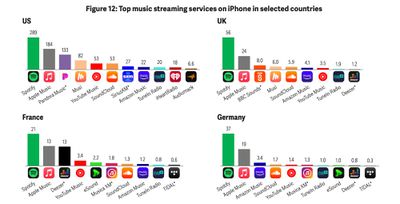
Apple in the newsroom article on the study pulls out several specific report highlights that it found notable:
- Third-party apps are the only options for consumers for entire types of apps, including social networking, dating services, travel planning, and food and drink.
- Leaders in app types often vary across countries, with many regional leaders outperforming their globally competitive counterparts.
- Third-party apps are the most popular among iPhone users in most regions for major app types, including music streaming, TV and movie streaming, reading, communication, and mapping apps.
- Across many app types, Apple's own apps account for a relatively small share of app usage among iPhone users. This is the case even though some Apple apps are preinstalled to enable core functionality of the device.
- iPhone users often use multiple apps within a single category, especially apps for communicating, reading the news, watching videos, or navigating -- underscoring how easily users can switch between apps and the breadth of opportunity for developers.
Apple also uses the newsroom article to point out the wide range of tools that it makes available to developers, along with the investments that it makes in the "next generation of developers" with tools like Everyone Can Code, App Development in Swift, and Swift Playgrounds.
Apple said that it does not expressly plan to provide this data to regulators like those developing the Digital Markets Act in Europe, but it is a public study and the company hopes regulators will take notice of the data and facts made available.
All of the data used for the study was sourced from Data.Ai (App Annie), and it looked at metrics like active users, time spent in apps, and total number of downloads. Though the data was sourced from a third-party measurement tool because Apple has limited data of its own, the company did say that it is partnering on the study and thus the data was within the realm of what's reflected in the internal information that Apple does have access to.
The full Analysis Group study on third-party apps on the App Store can be read on Apple's website























